Choosing between a tile roof and Colorbond can be tough. This article will compare durability, cost and appearance to help you decide.
Tile Roof vs Colorbond: Which is Best for Your Home
Deciding on the right roofing material for your home is a debate between tile roofs and Colorbond roofs. Both are popular in Australia, each with their own pros and cons. Tile roofs made from concrete, terracotta and slate are known for their durability, soundproofing and energy efficiency. These roofs can withstand the elements and look timeless on homes.
On the other hand, Colorbond roofs made from coated steel are known for their modern design and durability. They’re popular for new home builds because they’re affordable and low maintenance. Colorbond roofs are designed to reflect more of the sun’s heat which is a big plus in Australia’s hot climate. So if you want to increase your home’s energy efficiency, they’re a great option.
The decision between these two usually comes down to personal taste, visual appeal and specific needs. For example if you like a classic look with good soundproofing, a tile roof might be the way to go. If you prefer a sleek modern look with minimal maintenance, Colorbond roofing could be the answer. Budget and location also play a big part in this decision. Tile roofs are more expensive upfront but can save you in the long run due to their durability.
In the end it all comes down to budget, design and climate of your area. Both tile roofs and Colorbond roofs have proven to be effective in Australia’s climate so weigh the pros and cons before you decide.
Roofing is an essential part of any home, providing protection, insulation and visual appeal. In Australia, homeowners are often faced with a choice between two popular roofing materials: tile roofs and Colorbond roofs. Each has its own pros and cons so it’s a tough decision for many.
This blog post will help you choose the right roofing material by comparing the main differences between tile and Colorbond roofs. Whether you’re building a new home or renovating an existing one, you need to know these differences to make an informed decision.
In this comparison we will look at:
- Durability
- Thermal efficiency
- Maintenance needs
- Visual appeal
- Cost
- Environmental impact
We hope to provide you with a clear and concise analysis to help you decide which roof is best for your home and you.
Tile roofs and Colorbond roofs have different benefits that suit different architectural styles and personal preferences. From the classic and timeless look of tile roofs to the modern and sleek look of Colorbond, this guide will cover everything you need to know to decide.
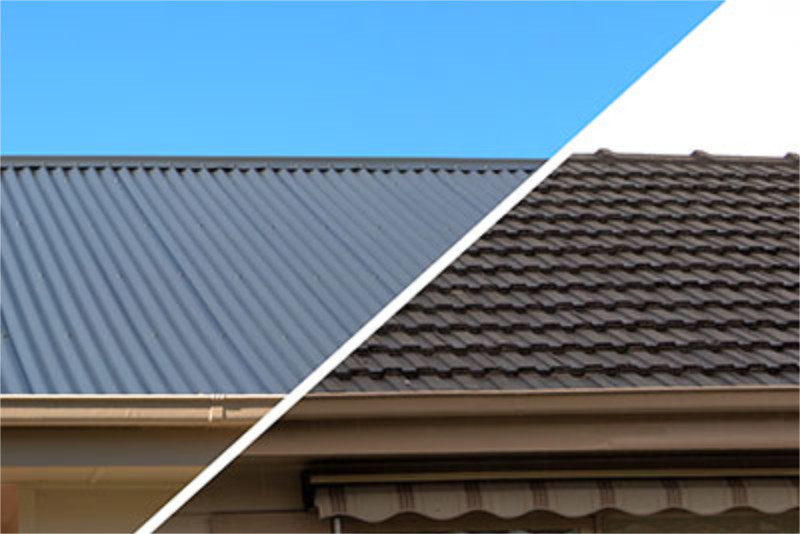
Tile Roofs and Colorbond Roofs
To decide between tile and Colorbond roofs you need to understand the main features of each. Tile roofs are a traditional roofing material known for their durability, soundproofing and energy efficiency. They’re made from materials like concrete, terracotta and slate each with its own benefits.
Colorbond roofs are made from high quality coated steel and are known for:
- Durability
- Modern look
- Lightweight construction
- Easy installation
- Low maintenance
What Are Tile Roofs?
Tile roofs have been around for centuries and are popular because of their strength and visual appeal. These tiled roofs are made from:
- Concrete: known for their durability and low maintenance and come in many colours to suit different styles.
- Terracotta: with their classic look are often used in Mediterranean and Spanish-style homes and are fire resistant so a good choice in bushfire prone areas.
- Slate: known for their natural beauty and longevity and come in many colours and textures.
Each has its own benefits so you can choose the one that suits you and your needs.
The visual appeal of tile roofs is one of their biggest advantages. The natural look of concrete and terracotta tiles can add a touch of sophistication and timelessness to any home. Plus:
- Highly durable and can withstand extreme weather
- Longer life than other roofing materials
- Good insulation, keeps the home cool in summer and warm in winter
- Fire resistant, added protection
- Low maintenance
But you need to consider that tile roofs can be heavier and may require a stronger structural support system which can add to the initial cost.
What Is Colorbond Roofing?
Colorbond roofing made from high quality coated steel roofing material is a popular choice for modern homes because of its strength and modern look. This roofing material can withstand harsh weather conditions, high winds, heavy rain and extreme temperatures. One of the biggest benefits of Colorbond roofing is low maintenance so a good option for homeowners looking for a low maintenance roofing solution.
In addition to its durability Colorbond roofing offers high customisation. Homeowners can choose from various profiles and colours so they can match the roof to their home’s style. Colorbond roofs are also lightweight so easier to install and often require less structural support than tile roofs.
Plus Colorbond roofs are termite, wind and fire resistant so an added layer of protection for your home.
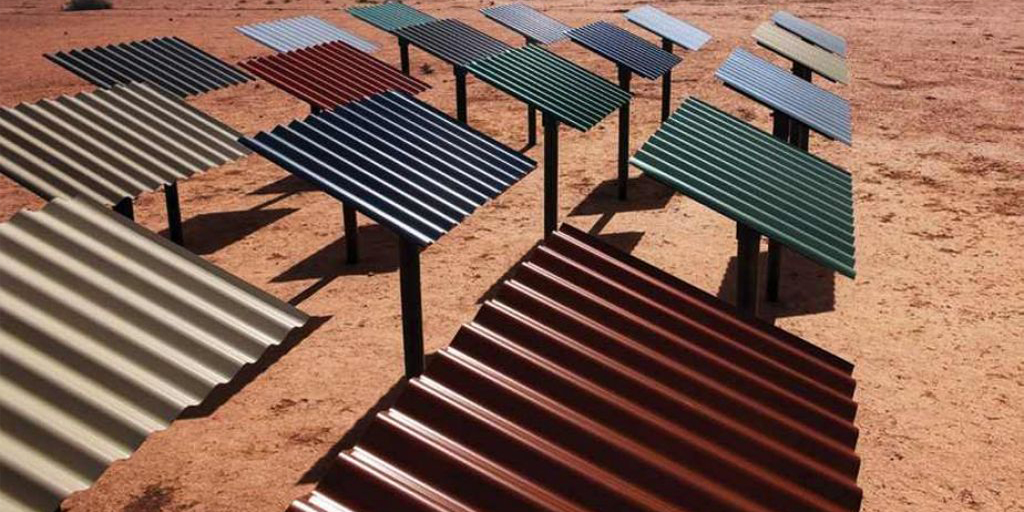
Durability and Longevity
Long lasting performance and durability are key when choosing a roofing material. Both tile and Colorbond roofs are durable but they differ in lifespan and maintenance.
Tile roofs made from heavy and durable materials can withstand extreme weather and last up to 100 years with maintenance. Colorbond roofs made from high quality coated steel can last 30 to 70 years depending on maintenance and exposure to weather.
Tile Roof Longevity
Tile roofs are known for their longevity, can last up to 50 years with maintenance. In some cases they can last up to 100 years if maintenance and roof repairs are done regularly. The durability of tile roofs is mainly due to the materials used, concrete and terracotta which are weather resistant and can withstand extreme temperatures and heavy rain.
Maintaining a tile roof:
- Regular inspections to check for cracked or broken tiles which can lead to leaks if not addressed
- Ongoing care and timely repairs
- Long term savings on repairs and replacements so cost effective in the long run.
Colorbond Roof Longevity
Colorbond roofs are designed to be long lasting and durable with a minimum of 50 years life. They undergo rigorous testing against corrosion and outdoor exposure so they can withstand hail, storms and high winds. Colorbond roofs are also backed by warranties, 30 year warranty against corrosion and weathering and 20 year warranty against paint flaking and chipping.
The durability of Colorbond roofs has many benefits:
- Less frequent replacements so conserves resources and reduces waste over time
- A durable option for homeowners
- An eco friendly option for those who want to reduce their carbon footprint.
Thermal Efficiency and Insulation
Any roofing material must be evaluated for thermal efficiency and insulation as they directly affect energy bills and indoor comfort. Tile and Colorbond roofs have different thermal properties. Tile roofs with its heavy thermal mass can store energy in the form of heat and regulate indoor temperatures and reduce energy consumption.
Colorbond roofs on the other hand use advanced solar reflection technology to keep homes cooler by reflecting more of the sun’s heat.
Tile Roof Thermal Properties
Tile roofs are good for thermal insulation, to maintain indoor temperature and reduce energy bills. The natural thermal resistance of concrete and clay tiles creates a barrier that prevents heat transfer, keeps homes cooler in summer and warmer in winter. This thermal mass effect is more beneficial in areas with big temperature fluctuations as it helps to stabilise indoor temperature and reduce the need for artificial heating and cooling.
But note that tile roofs can absorb heat which may not be good in hotter climates. Proper installation and ventilation can mitigate this issue so tile roofs can provide good thermal insulation and contribute to overall energy efficiency.
Colorbond Roof Thermal Efficiency
Colorbond roofing is designed to be thermally efficient through its solar reflection technology. Most Colorbond steel colours have Thermatech® solar reflectance technology which helps to reflect more of the sun’s heat, keep homes cooler and reduce the need for aircon. This reflective property is more beneficial in hot climates as it reduces cooling costs and improve energy efficiency.
And
- Lighter design
- Cooler at night so indoor environment is more comfortable
- Less heat radiation into the building so energy consumption is lower.
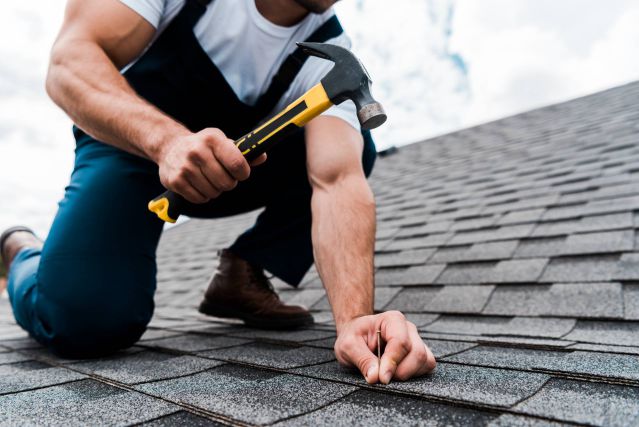
Maintenance and Repairs
One must consider the maintenance and repair requirements of roofing materials for long term cost effectiveness and durability. Tile roofs need more maintenance especially after extreme weather events to ensure all tiles are intact and in good condition.
Colorbond roofs with its smooth and resistant surface needs less maintenance, just regular cleaning and inspections to maintain its appearance and function.
Tile Roof Maintenance
Maintaining a tile roof involves regular inspections and cleaning to prolong its life and performance. Professional inspections every 12 months is recommended to detect and address potential issues early. After extreme weather conditions, additional inspections are necessary to check for damage.
Tile roofs are prone to moss and lichen growth which can trap moisture and damage the tiles. Regular cleaning can prevent these problems and maintain the roof’s integrity. Cracked or broken tiles should be replaced immediately to prevent roof leaks and structural damage.
This can involve lifting and replacing individual tiles, a process that requires careful handling to avoid further damage. While tile roofs are durable, their maintenance needs are higher than Colorbond roofs so regular maintenance is necessary to maximise its life.
Colorbond Roof Maintenance
Colorbond roofs are known for its low maintenance requirements. The smooth surface of Colorbond roofs is easy to clean, just a spray from a hose can remove dirt and debris. Regular cleaning and washing is enough to keep the roof in top condition and harsh chemicals should be avoided to prevent damaging the coating.
To prevent galvanic corrosion, Colorbond roofs should not be in contact with incompatible metals. Using non-metallic insulators can help with that. Overall Colorbond roofs minimal maintenance needs makes it a great option for homeowners looking for low maintenance roofing solution.
Aesthetic and Design
The aesthetic and design of roofing materials greatly affects the overall look of a house. Tile roofs and Colorbond roofs has its own visual style that suits different architectural tastes.
Tile roofs has a classic and timeless look, adds character and elegance to homes. Colorbond roofs has a modern and sleek look with wide range of color options, suitable for contemporary designs.
Tile Roof Designs
Tile roofs come in different shapes, colors and textures, homeowners can create their own unique look. Some options are:
- Terracotta tiles, available in different colors, including contemporary metallic finishes like Mars and Comet
- Urban Shingle tiles, flat and seamless design perfect for Hamptons and Mid-Century home designs
- Nouveau tiles, clean lines and grey-tone palettes
- Marseille tiles, French inspired and available in grey-toned and natural clay colors
Tile roofs are versatile and suitable for various architectural styles, from traditional to modern. The natural materials used in tile roofing such as concrete or terracotta tiles gives a sophisticated look that enhances the curb appeal of any home. A concrete tile roof in particular has durability and timeless look, that’s why roof tiles is a popular choice for homeowners looking for a tiled roof.
Colorbond Roof Styles
Colorbond roofs has high level of customization with 22 color and profile options to match any home design. Homeowners can choose from different color options tailored to different architectural styles, both contemporary and classic. Popular Colorbond colors are:
- Cottage Green
- Jasper
- Shale Grey
- Deep Ocean
- Pale Eucalypt
This gives a wide range of options.
In addition to color options, Colorbond roofs comes in different profiles, corrugated, ribbed and flat finishes, to further customize. The sleek and clean look of Colorbond roofs suits modern architectural designs, that’s why it’s a popular choice for new home builds and renovations.
Environmental Impact
For eco-friendly homeowners, the environmental impact of roofing materials is a consideration. Both tile and Colorbond roofs has eco-friendly features but they differ in its environmental benefits. Tile roofs are made from natural materials like clay and concrete which do not deplete limited natural resources.
Colorbond roofs are made from steel that has recycled content and 100% recyclable.
Eco-Friendly Tile Roofs
Tile roofs has benefits:
- Made from raw materials like clay and concrete which are abundant and do not deplete limited natural resources.
- Can be recycled at the end of its lifecycle, reduces waste and contributes to sustainability.
- Density and thickness of tile roofing provides excellent sound insulation and acoustic performance, improves overall living environment.
Tile roofs thermal insulation also helps in energy efficiency by regulating indoor temperature, reduces the need for artificial heating and cooling. This means lower energy bills and smaller carbon footprint, tile roofs is an eco-friendly option for homeowners.
Green Benefits of Colorbond
Colorbond roofing materials is designed with environmental sustainability in mind. The steel used in Colorbond roofs has recycled content and is fully recyclable, minimizes waste and conserves resources. Choosing pale-toned Colorbond roofs also helps in cooler local communities by reducing heat absorption, which helps to mitigate urban heat island effect.
Also, Colorbond roofs has Thermatech® solar reflectance technology that enhances its thermal efficiency by:
- reflecting more of the sun’s heat
- reducing air conditioning
- lower energy consumption
- reducing greenhouse gas emissions.
Cost
Price is a consideration when choosing between tile and Colorbond roofs. Both has long term benefits but initial and long term cost differs. Tile roofs is more expensive to install but has durability and long term savings.
Colorbond roofs is more affordable upfront and less maintenance over time.
Initial Cost
The initial installation cost of tile roofs and Colorbond roofs are far apart. Tile roofs depending on type can cost between $45 to $500 per square meter, concrete and terracotta tiles from $45 to $80 per square meter and slate tiles up to $500 per square meter. The installation of tile roofs also requires a strong roof structure to support its weight which adds to the overall cost.
Colorbond roofing is generally more affordable, from $50 to $70 per square meter. Re-roofing with Colorbond is also more cost-effective, around $30,000 plus GST compared to $35,000 plus GST for tile roofs. This makes Colorbond a great option for homeowners looking for budget friendly roofing.
Long Term Savings
When looking at long term savings, both tile and Colorbond roofs has its advantages. Colorbond roofing is cheaper to maintain over time, its smooth surface requires minimal maintenance. Properly installed insulation under Colorbond roofs can also reduce energy cost by improving the building’s energy efficiency. Also, the reflective properties of Colorbond roofs can lower cooling cost during hot weather.
Tile roofs has its advantages:
- Durability and can withstand extreme weather condition
- Long term savings due to its durability
- Solar tiles can generate free energy, reduces power bills and reliance on fossil fuels
- The thermal mass of tile roofs helps in regulating indoor temperature, energy efficiency and cost savings over time.
Post-Build Installations
Post construction installations like solar panels or air conditioning units requires thoughtful consideration based on the roofing material. Both tile and Colorbond roofs has its own challenges and requirements for additional installations. Knowing these factors will help homeowners make informed decisions and avoid potential problems during installation.
Installing on Tile Roofs
Installing systems like solar panels on tile roofs requires specific steps and considerations. Here are the steps involved:
- Measurements and evaluation of roof square footage, slope and orientation is crucial before installation.
- Adding new system often requires removing, modifying and replacing tiles to accommodate mounting brackets which can be time consuming and requires professional expertise.
- The rail system for solar panels on tile roofs is made of aluminum alloy and fastened to brackets at regular intervals to ensure stability and efficiency.
While tile roofs provide a solid base for installations, the process is more complex compared to Colorbond roofs. You should work with professional roofing contractors to ensure installation is done correctly and not compromise the roof.
Installing on Colorbond Roofs
Installing additional systems on Colorbond roofs such as solar panels or air conditioning units involves:
- Colorbond roofs is lightweight, easy to work with.
- Cutting parts of the roof is required during installation which can increase labor and cost.
- Colorbond roofs can be noisy during heavy rain or hail which is an important factor to consider when planning installation.
Structural modification may be required to ensure proper setup and stability for systems like air conditioning units. Despite the challenges, Colorbond roofs is a flexible and durable base for post-build installation which makes it a popular choice for modern homes.
Conclusion
In summary, both tile and Colorbond roofs has its own advantages and cater to different homeowner needs and preferences. Tile roofs has classic and timeless look, good soundproofing and energy efficiency through its heavy thermal mass. It’s durable and can last up to 100 years with proper maintenance, a long term investment.
Colorbond roofs has modern look, durable and low maintenance. It has excellent thermal efficiency through solar reflection technology and environmentally friendly because it’s recyclable. Choosing between the two depends on budget, aesthetic and climate challenges.
In the end, both tile and Colorbond roofs has proven to be effective in protecting Australian homes. By knowing the pros and cons of each, homeowners can make informed decision that suits their needs and increase the value of their property when doing there next roof restoration.
FAQs
What are the materials used in tile roofs?
Tile roofs are made of concrete, terracotta or slate each with its own advantage of durability and visual appeal.
How long is Colorbond roofs good for?
Colorbond roofs last between 30 to 70 years but this can vary depending on maintenance and weather exposure.
Are tile roofs more expensive to install than Colorbond roofs?
Yes, tile roofs is more expensive to install than Colorbond roofs, prices vary depending on the type of tile used.
Why is Colorbond roofs environmentally friendly?
Colorbond roofs is environmentally friendly because it’s made of steel with recycled content and fully recyclable. Also its solar reflection technology reduces thermal efficiency and energy consumption.
How often should tile roofs be checked and maintained?
Tile roofs should be checked by professionals at least once a year and after severe weather.

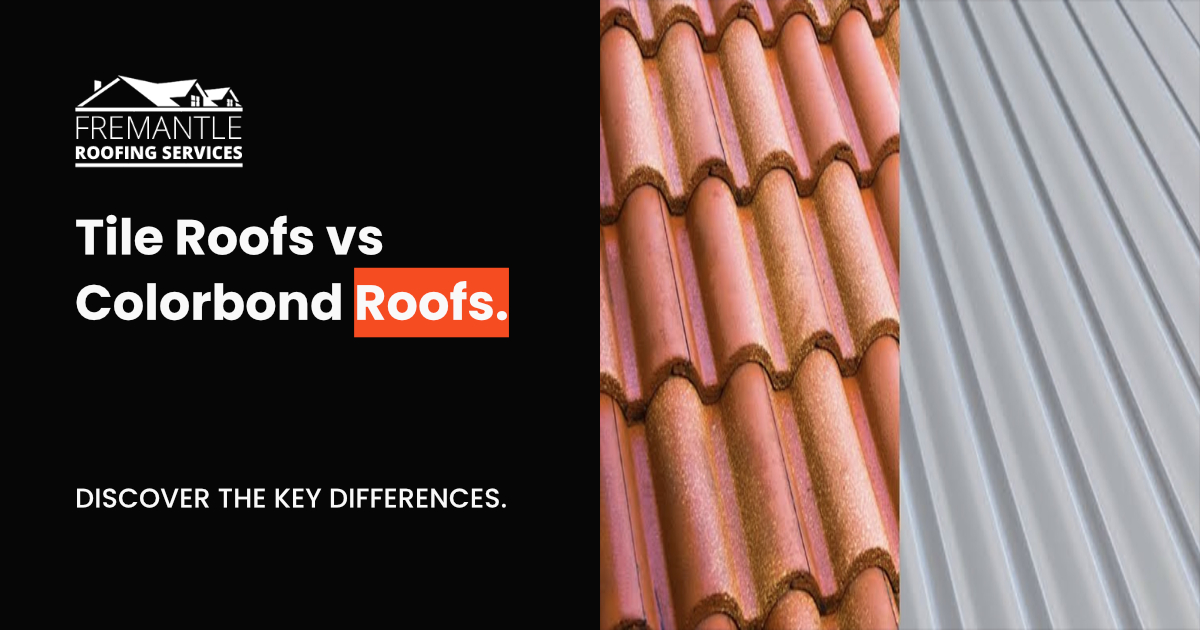
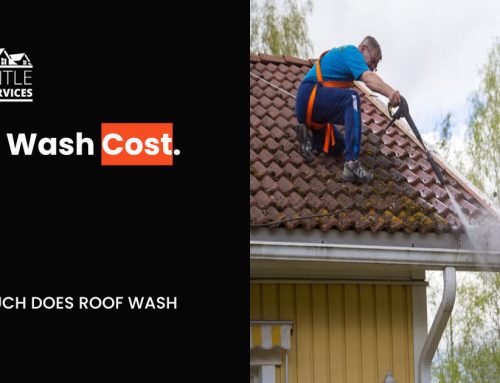
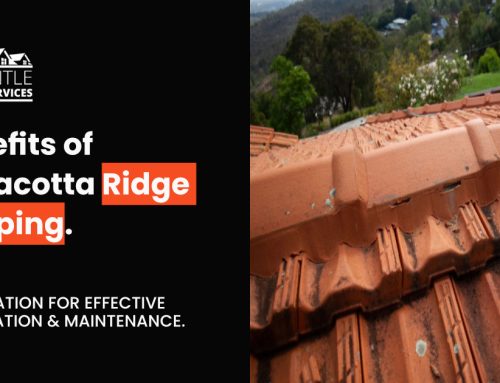
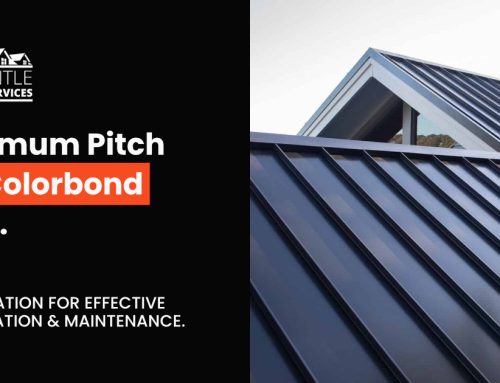
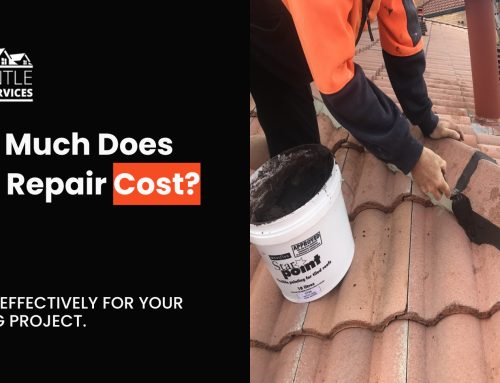
Leave A Comment